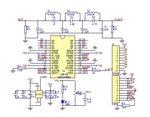Garyl
Full Member level 5

Hey,
I am going to make a AD9834 signal generator - I will etch the PCB and solder the SMD components, but I like to ask first if the schematic and board is correct.
I have chosen to use the Roland Cordesses PCB project:
**broken link removed**
here is the PCB:
View attachment ad9834N_Cbd.pdf
and the schematic:
View attachment gen9834.pdf
I am going to interface it with Arduino UNO.
and I have followingn questions:
1. Is this PCB and schematic correct?
2. How/where do I buy that U4 20MHz oscillator? There is no part name and searching for 20MHz yields me only common two-pin crystals like the ones used at OSC pins of AVRs and other MCUs
3. For the 20/40/80m receiver/transceiver VFO usage, I need a square waveform output, right?
**broken link removed**
I'd like to get a wide band covered in my receiver.
5. Do you have any other suggestions/hints for me using that DDS project for my ham receiver?
Thanks in advance!
I am going to make a AD9834 signal generator - I will etch the PCB and solder the SMD components, but I like to ask first if the schematic and board is correct.
I have chosen to use the Roland Cordesses PCB project:
**broken link removed**
here is the PCB:
View attachment ad9834N_Cbd.pdf
and the schematic:
View attachment gen9834.pdf
I am going to interface it with Arduino UNO.
and I have followingn questions:
1. Is this PCB and schematic correct?
2. How/where do I buy that U4 20MHz oscillator? There is no part name and searching for 20MHz yields me only common two-pin crystals like the ones used at OSC pins of AVRs and other MCUs
3. For the 20/40/80m receiver/transceiver VFO usage, I need a square waveform output, right?
4. How do I calculate that low pass filter there for the 20/40/80 bands, and do I have to use separate filter for each band?- The output relay allowing selection of sine/triangle or square waveform can be omitted if not necessary.
I have seen such calculators, but how do I choose frequency limits, etc?- The inductor on the left of the PCB (picture below) is a part of the elliptic low-pass filter rejecting the DDS clock frequency. Such filters can be designed with the help of filter tables in the Zverev's "Handbook of Filter Synthesis" (or in the much less expensive "ARRL Handbook") or with one of the many softwares available.
**broken link removed**
I'd like to get a wide band covered in my receiver.
5. Do you have any other suggestions/hints for me using that DDS project for my ham receiver?
Thanks in advance!





